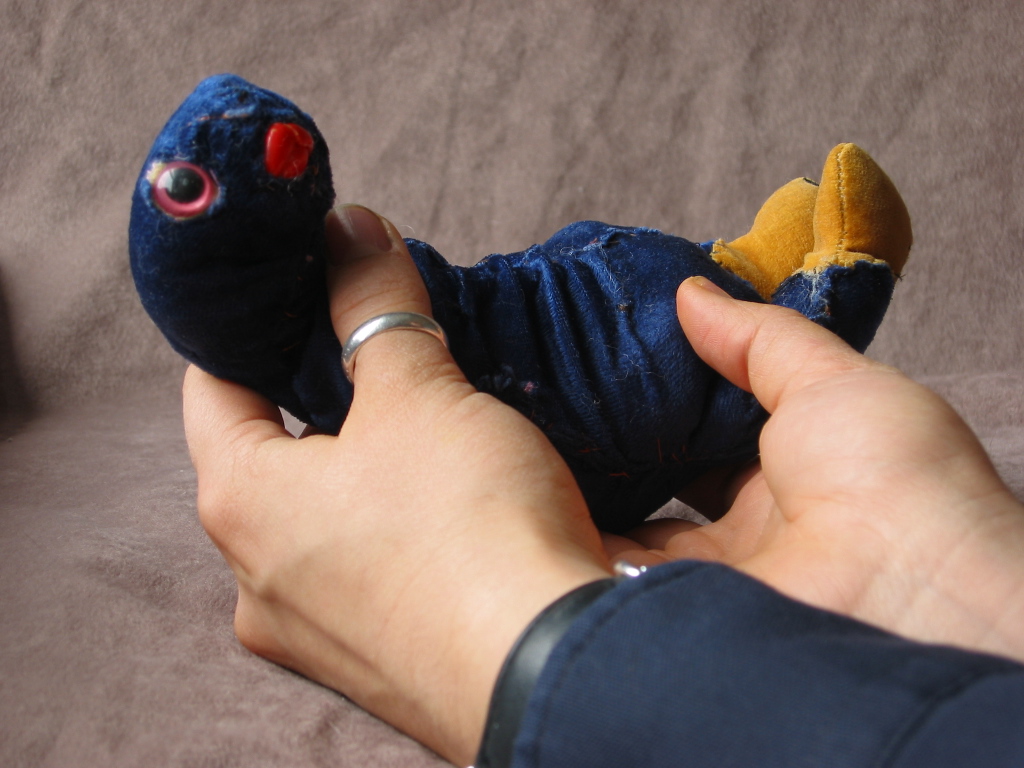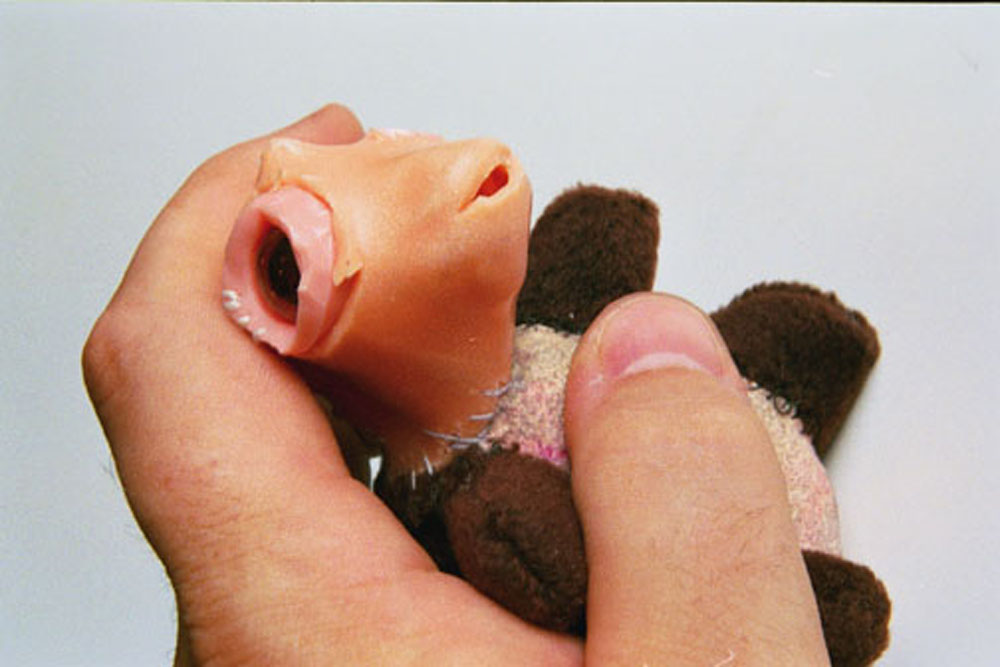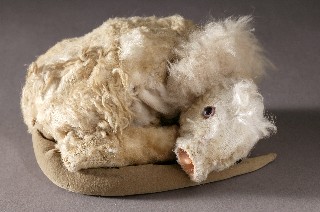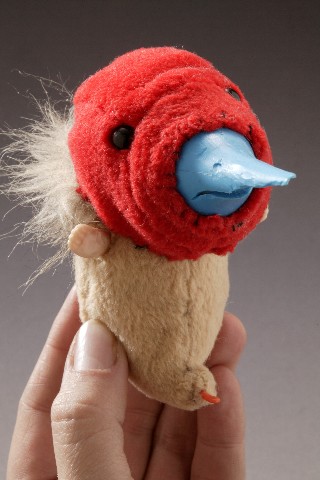Anastasia Ward: The Re-Fleshing of Childhood
Amanda Vail speaks here with Anastasia (Asia) Ward about her intriguing and evocative sculptures and about what they are turning into.




For several years now, Anastasia Ward has been taking her cue from Mary Shelley. She sits in her studio and under a lone lamp’s spotlight, upon a desk filled with bits of wire, motors, batteries, sketches, and tools, she recreates toys. Nearby sits a box overflowing with stuffed animals rescued from garage sales and Salvation Army stores, waiting for Ward to give them new life. She gathers them together for their textured, worn-out fur, for their small beady eyes, for their funny little noses. She pulls them apart and puts them back together turned inside-out and backwards, no longer recognizable as “My Little Ponies” and “Popples,” but something new and strange, somewhat monstrous and oddly endearing.
Ward’s creations are, without a doubt, initially unsettling; they simultaneously repulse and attract the viewer. If their strange hybridity was their only quality, the repulsion might win out. However, Ward has given them life, of a sort, through the inclusion of motors, music boxes, and springs. They jiggle, shuffle, squeak, and recoil; one of them even cries when the lights go out. Their names, such as “Blind Lion” or “Fraidy Cat,” inspire a kind of pity in the viewer. These are not monsters; they are creatures to be taken care of. They require interaction, maintenance and cuddling. Despite their awkward, unnatural appearances, they are still in need of love and attention.
Ward works very hard to balance her pieces. The line she walks between the extremes of grotesque and adorable is a very fine one: too far in either direction allows the viewer to become comfortable with the creature. Oftentimes, Ward’s creations have multiple incarnations, changing their appearance drastically over the course of several months or years. One such piece, “Rat,” does not look very much like a rat at all, although it did initially. Now, it’s more like a sleeping sheepdog, if a sheepdog could have no ears, a short anteater-like snout, only two long legs, and the tail of a rat. It has a volume control on its back which, when adjusted, causes the creature to breathe more rapidly or less so, and emits a sound not unlike a heart monitor. It is very easy to believe that this creature, despite its openly staring eyes, is dreaming of chasing rabbits, like a sheepdog, or perhaps taunting cats, like a rat. It remains trapped, though, neither awake nor asleep, but suspended in dream. “Rat” will never become one thing or another and thus speaks most tellingly to one of Ward’s strongest themes, that of adolescence.
It is the state of being that is neither one thing nor another which seems to be the hardest thing to live with. Transition is never easy. It is no stretch to say that the majority of people would probably never wish to return to their teenage years. Ward’s work confronts the awkwardness of that time, as well as the awkwardness of remembering it. She doesn’t explain it away or make it comfortable in any way – no one can. What her sculptures do, however, is to shift us out of our firm state of being for just a bit of time. The reaction to them goes beyond logical thought into something more visceral. Those things which used to be so important to us no longer even register on our consciousness. The small, hybrid creatures remind us of where we’ve been and of the struggles that brought us to where we are.
Ward’s work has been undergoing its own evolution of late. Up until recently, she viewed her small creatures as artworks in and of themselves. Over the summer of 2004, however, she received an internship at Franconia Sculpture Park which allowed her to work on a large scale for the first time. “Flying Horse” was conceived from an earlier, smaller work (which had already evolved into something else by the time she began work at Franconia). Translating the floppy, tough-skinned pink giraffe-like horse into a monumental being was a challenge, but Ward went at it with her usual determination and innovation. While the original pink horse may have been hard to the touch, contradicting one’s expectation for it to be plush, the giant white pegasus surprises by being soft. The steel framework is stuffed with batting around which rolls of white vinyl have been hand-stitched and shrunk. Like any of her sculptures, it requires interaction on the part of the viewer; in order for the horse to “fly,” a person must pull on the cord dangling from its belly so that its wings flap.
“Flying Horse” opened up a whole can of worms for Ward. Suddenly, her small cuddly creatures have become maquettes for life-size sculptures. Looking back at them, she perceives a whole new meaning to their constant evolution. Some of them are not suited to larger bodies as they would become too intimidating, too scary. However, she has tentatively chosen two sculptures for future expansion, “Rat” and “Pink Eyes.” The problem now becomes how to animate them; over the next year, Ward will begin experimenting with different methods of calculated motion. “Pink Eyes” is slated to be her first attempt.
This little, some day to be big, guy is a small blue worm with big eyes, hard red lips, and yellow boots. He generally sits quietly hunched over his belly, but when his neck is pulled on, hard, he stretches out with an awful cranking noise and then begins to slowly curl up to the tune of a delicate music box. Someday he’ll be a six-foot long worm, roughly four feet high and fully automated. He’ll still be soft and vaguely cuddly, but will charge the entire space around him with tension. “Pink Eyes” will interact on an adult level, no longer something to be taken care of but something to take care of. The same could be said of Ward’s work; the pace is definitely beginning to pick up. Watch out for her creations soon in a gallery near you.
Click on the Related Content button at the foot of the list to the right to view a movie of one of these pieces–“Lips”– in action.